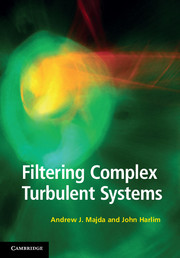Book contents
- Frontmatter
- Contents
- Preface
- 1 Introduction and overview: Mathematical strategies for filtering turbulent systems
- Part I Fundamentals
- Part II Mathematical guidelines for filtering turbulent signals
- Part III Filtering turbulent nonlinear dynamical systems
- 9 Strategies for filtering nonlinear systems
- 10 Filtering prototype nonlinear slow–fast systems
- 11 Filtering turbulent nonlinear dynamical systems by finite ensemble methods
- 12 Filtering turbulent nonlinear dynamical systems by linear stochastic models
- 13 Stochastic parametrized extended Kalman filter for filtering turbulent signals with model error
- 14 Filtering turbulent tracers from partial observations: An exactly solvable test model
- 15 The search for efficient skillful particle filters for high-dimensional turbulent dynamical systems
- References
- Index
12 - Filtering turbulent nonlinear dynamical systems by linear stochastic models
from Part III - Filtering turbulent nonlinear dynamical systems
Published online by Cambridge University Press: 05 March 2012
- Frontmatter
- Contents
- Preface
- 1 Introduction and overview: Mathematical strategies for filtering turbulent systems
- Part I Fundamentals
- Part II Mathematical guidelines for filtering turbulent signals
- Part III Filtering turbulent nonlinear dynamical systems
- 9 Strategies for filtering nonlinear systems
- 10 Filtering prototype nonlinear slow–fast systems
- 11 Filtering turbulent nonlinear dynamical systems by finite ensemble methods
- 12 Filtering turbulent nonlinear dynamical systems by linear stochastic models
- 13 Stochastic parametrized extended Kalman filter for filtering turbulent signals with model error
- 14 Filtering turbulent tracers from partial observations: An exactly solvable test model
- 15 The search for efficient skillful particle filters for high-dimensional turbulent dynamical systems
- References
- Index
Summary
In the previous chapter, we discussed the L-96 model and showed the skill of two ensemble square-root filters, ETKF and EAKF, on filtering this model in various turbulent regimes. As we discussed in Chapter 1, with the ensemble approach, there is an inherently difficult practical issue of small ensemble size in filtering statistical solutions of these complex problems due to the large computational overload in generating individual ensemble members through the forward dynamical operator (Haven et al., 2005). Furthermore, as we have seen in Chapter 11, the ensemble square-root filters (ETKF, EAKF) on the L-96 model suffer from severe catastrophic filter divergence, where solutions diverge beyond machine infinity in finite time in many chaotic regimes, when the observations are partially available. For the two-layer QG model, we also found that extensive calibration is needed on the EAKF with the local least-squares framework to avoid catastrophic filter divergence (see chapter 11 and Harlim and Majda (2010b)); yet, the filtered solutions are not accurate in the numerically stiff “oceanic” regime. Naturally one would ask whether there is any skillful reduced filtering strategy that can overcome these challenges of computational overhead.
In this chapter, we discuss a radical approach for filtering nonlinear systems which has several desirable features including high computational efficiency and robust skill under variation of parameters. In particular, we implement an analogue of the Fourier diagonal filter as developed in Chapters 6–8 on the nonlinear L-96 model discussed in Chapter 11 with varying degrees of nonlinearity in the true dynamics ranging from weakly chaotic to fully turbulent.
- Type
- Chapter
- Information
- Filtering Complex Turbulent Systems , pp. 214 - 235Publisher: Cambridge University PressPrint publication year: 2012



